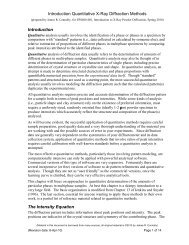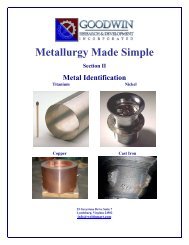Metallography and Microstructures of Cast Iron
Metallography and Microstructures of Cast Iron
Metallography and Microstructures of Cast Iron
Create successful ePaper yourself
Turn your PDF publications into a flip-book with our unique Google optimized e-Paper software.
582 / <strong>Metallography</strong> <strong>and</strong> <strong>Microstructures</strong> <strong>of</strong> Ferrous AlloysFig. 75 As-cast gray iron (Fe-2.8%C-1.85%Si-1.05%Mn-0.04%P-0.025%S). Pearlitic matrix.Etched with 4% nital. 100Fig. 77 As-cast gray iron. Pearlitic-ferritic matrix withphosphorous eutectic (E). Etched with 4% nital.100A high degree <strong>of</strong> undercooling <strong>of</strong> hypereutecticgray iron can promote the solidification <strong>of</strong>very fine, pointlike type D graphite with an interdendriticdistribution, as shown in Fig. 63. Inthe other direction, undertreatment <strong>of</strong> the graphitizinginoculants, such as ferrosilicon, producesother flake graphite types in gray iron. For example,Fig. 64 shows a hypereutectic gray ironwith graphite type C, where very coarse, needlelikeflakes (kish graphite) form before the eutectic,which is very fine. Kish graphite, which isshown in Fig. 64, can be changed into a starlikegraphite, shown in Fig. 65, under higher coolingrates, which is referred to as type V (plate I <strong>of</strong>ASTM A 247). The carbide-forming alloy elements,for example, chromium, manganese, <strong>and</strong>vanadium, <strong>and</strong> the low-melting-point metals, forexample, bismuth, lead, <strong>and</strong> sulfur, also affectgraphite morphology.Nodular Graphite in Ductile <strong>Iron</strong>. The addition<strong>of</strong> magnesium in the inoculation processdesulfurizes the iron <strong>and</strong> makes graphite precipitateas nodules rather than flakes. Moreover, mechanicalproperties are greatly improved overgray iron; hence, nodular iron is widely knownas ductile iron. Nodule size <strong>and</strong> shape perfectioncan vary, depending on composition <strong>and</strong> coolingrate. Figure 66 shows fine nodules with a maximumdiameter <strong>of</strong> 20 lm in a chill-cast thin section,while Fig. 67 <strong>and</strong> 68 show coarser nodules,with maximum diameters <strong>of</strong> 40 <strong>and</strong> 100 lm, respectively.Note that the number <strong>of</strong> nodules perunit area is different <strong>and</strong> changes from approximately350 to 125 to 22/mm 2 , respectively, forFig. 66 to 68.Certain factors can cause weak nodularity.Figure 69 shows an irregular graphite shape dueto poor inoculation or excessive fading <strong>of</strong> inoculant.Exploded graphite, shown in Fig. 70, mayoccur due to excessive rare earth additions. Normally,it is found in thick-section castings or athigher-carbon equivalents (Ref 11). Figure 71shows chunky <strong>and</strong> spiky types <strong>of</strong> graphite. Thefirst one is caused by high-purity charge mate-Fig. 76 Same as in Fig. 75. Fine pearlite. 500Fig. 78 Same as in Fig. 77. E, ternary phosphorous eutectic;P, pearlite; <strong>and</strong> F, ferrite. 500Fig. 79 As-cast gray iron (Fe-3.4%C-3.4%Si-0.07%Mn-0.04%P-0.03%Cr-0.47%Cu). Ferritic-pearliticmatrix. Etched with 4% nital. 100








